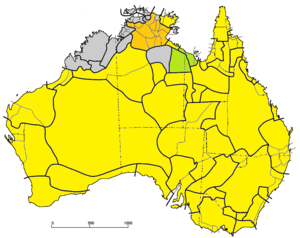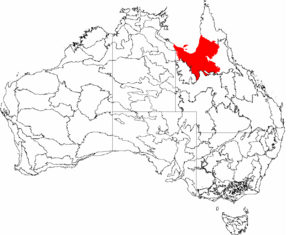Pama–Nyungan languages facts for kids
Quick facts for kids Pama–Nyungan |
|
|---|---|
| Geographic distribution: |
most of mainland Australia, with the exception of northern parts of Northern Territory and Western Australia |
| Linguistic classification: | Macro-Pama–Nyungan?
|
| Proto-language: | Proto-Pama–Nyungan |
| Subdivisions: |
Yolŋu, Ngarna, Kalkatungic, Mayi, Paman, Kala Lagaw Ya, Yidiny, Dyirbalic, Maric, Waka–Kabic, Durubulic, Bandjalangic, Gumbaynggiric, Anewan, Wiradhuric, Yuin–Kuric,
plus unclassified languages
|
 Pama–Nyungan languages (yellow)
Other Macro-Pama–Nyungan (green and orange) |
|
The Pama–Nyungan languages are a huge group of languages spoken by Indigenous Australians across most of Australia. Out of about 400 Aboriginal languages, over 300 of them belong to this family.
The name "Pama–Nyungan" comes from two words. "Pama" means "man" in languages from the northeast of Australia. "Nyunga" means "man" in languages from the southwest. So, the name covers the whole range of these languages, from one end of Australia to the other!
Other language families in Australia are sometimes called "non-Pama–Nyungan." This just means they are not part of this big family. The Pama–Nyungan family covers most of Australia's land. It also includes most of the Aboriginal population and the largest number of languages.
Most Pama–Nyungan languages are spoken by small groups of people. Sadly, many of these languages have disappeared. This happened because of diseases or because their speakers were removed from their lands. Almost all the remaining languages are in danger of disappearing. Only in the central parts of Australia are Pama–Nyungan languages still spoken strongly by everyone in the community.
A linguist named Kenneth L. Hale first identified and named the Pama–Nyungan family. His research showed that one large, related language family had spread across most of Australia. About a dozen other language families were found mainly along the northern coast.
Contents
How Pama–Nyungan Languages Spread
| Proto-Pama–Nyungan | |
|---|---|
| Reconstruction of | Pama–Nyungan |
| Region | Gulf Plains, NE Australia |
| Era | perhaps ca. 3000 BCE |
Scientists believe that the original language, called Proto-Pama–Nyungan, was spoken about 5,000 years ago. This is much more recent than the 40,000 to 60,000 years that Indigenous Australians have lived in Australia.
It's not fully clear how these languages spread across most of the continent. One idea is that languages might have spread along with culture and traditions. It seems that many different groups shared their languages over time. This suggests there were many waves of cultural contact between groups.
Using computer analysis, researchers think the Pama–Nyungan languages started to spread about 5,000 years ago. This spread began from the Gulf Plains in northeastern Australia.
Classifying Pama–Nyungan Languages
At the time Europeans arrived in Australia, there were about 300 Pama–Nyungan languages. These were divided into about three dozen main groups. Some of these groups are very different from each other. Others are almost like different ways of speaking the same language.
Traditional Groups
Here are some of the main groups, moving around the coast and then inland:
- Along the east coast, from Cape York to the Bass Strait, you would find groups like:
- Paman (41 languages)
- Dyirbalic (5 languages)
- Maric (26 languages)
- Bandjalangic (4 languages)
- Yuin–Kuric (14 languages)
- Along the south coast, from Melbourne to Perth, there were groups such as:
- Kulinic (13 languages)
- Lower Murray (9 languages)
- Thura-Yura (8 languages)
- Nyungic (11 languages)
- Up the west coast, you would find:
- Cutting inland, south of the northern non-Pama–Nyungan languages, were:
- Ngumpin–Yapa (10 languages)
- Warluwaric (5 languages)
- Kalkatungic (2 languages)
- In the middle of Australia, surrounded by these groups, were:
- Separated to the north was the Yolŋu group (10 languages).
Some of these classifications are not certain. Many languages disappeared before they could be properly studied.
Modern Computer Classification
In 2012, researchers Bowern and Atkinson used computers to help classify these languages. This method helped them understand how the languages are related. They found four main branches:
- Southeastern (languages in Victoria and New South Wales)
- Northern (languages in the Gulf region and Pama-Maric groups)
- Central (languages like Arandic, Thura-Yura, and Karnic)
- Western (languages like Yolŋu, Ngarna, and Nyungic groups)
Is Pama–Nyungan a Single Family?
For a while, some experts, like Robert M. W. Dixon, wondered if Pama–Nyungan was truly one big language family. He thought that maybe these languages were more like a "language area" where different languages influenced each other over a very long time, rather than all coming from one single ancestor language.
However, most linguists now agree that Pama–Nyungan is indeed a single language family. They have used different methods to show this.
Evidence for a Single Family
In 2004, a collection of research papers showed that many traditional Pama–Nyungan groups are related. They used the "comparative method," which looks for similar words and grammar rules across languages to show they share a common origin.
Kenneth L. Hale, the linguist who first identified the family, strongly supported the idea that Pama–Nyungan is one family. He found many words that were similar between languages thousands of kilometers apart. These words showed regular sound changes, which is strong proof of a shared ancestor. He compared the age of the Pama–Nyungan family to that of Proto-Indo-European, a very old language family that includes English and many other European languages.
More recently, in 2012, Bowern and Atkinson used advanced computer models. These models helped them see the connections between Pama–Nyungan languages more clearly. They found that these languages do share features that show they are part of one family. Their computer model is now the main way experts understand how Pama–Nyungan languages are related and how they changed over time.
See also
 In Spanish: Lenguas pama-ñunganas para niños
In Spanish: Lenguas pama-ñunganas para niños


